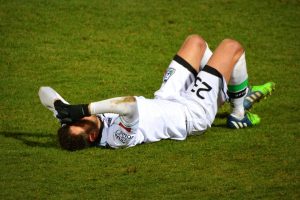Football injuries in perspective
In a strange way, avoiding football injuries should not be at the forefront of your mind. This is because too much focus on the possibility of injury might make you nervous. Consequently, it can mean you are less committed to tackles or challenging situations.
In addition, anxiety about an injury can make the body tense up. Ironically, this can lead to problems being more likely. But clearly, you don’t want to get injured. So what can you do?
The trick to avoiding football injuries
The key to reducing your chances of an unwanted injury is preparation. You need to think about what is under your control. Although sometimes, injuries are not under our control, however, preparing for avoiding these injuries is up to you. Obviously, what is not under your control is the actions of your opponents. But how you prepare and recover from a game is very much down to you.
Most of what you do during a game should be instinctive. But prior to and after a game you need to very carefully prepare the body and allow it to recover.
Aspects of a good warm-up
The science behind the warm-up has progressed in recent years. There is a model for a thorough warm-up called the RAMP model. This is a simple acronym to walk you through the process and can aid you in designing complete warm-ups.
The ‘R’ stands for raise. In this initial stage, you are looking to raise body temperature, heart rate and blood flow. This has always been important. This first phase can be as basic as a jog that gradually increases in pace. But these days often involves skip steps, short sprint technique drills and direction change.
The letters ‘A’ and ‘M’ stand for activate and mobilise. The goal here is to get key muscle groups firing and to increase range of motion in the joints. In brief, this can include activities with mini-bands, spine-mobilisation and balance work.
And finally, the ‘P’ stands for potential or performance. The goal here is to increase mental as well as physical acuity. These exercises are performed at a level close to the intensity of the game. They include drills such as light plyometrics, cone drills or short acceleration bursts.
This full warm-up can last as long as 10-15 minutes. For further ideas on useful equipment and ideas visit try visiting SAQInternational.
It is interesting to note, that the type of stretching you do during this session should be movement based (dynamic). Static stretching prior to a game is out of vogue. Indeed, there is some evidence to suggest that this can reduce force production.
The cool-down
The cool-down (or warm-down) is less involved, but no less vital than the warm-up. There are 3 key things that should be kept in mind to help with avoiding subsequent football injuries.
- However tired you are after a game – try to keep moving (gentle movements) for a short period of time. This will allow your heart rate to normalise slowly.
- Take slow and controlled breaths to help restore your natural breathing pattern
- Incorporate low-intensity but long static stretches for key muscles groups.
A final word
We hope this information is useful for you. If you need advice or have any questions about our treatments, please contact us. You can find us in Mill Hill Broadway and Islington. We are always happy to help. If you like this blog, please share!




